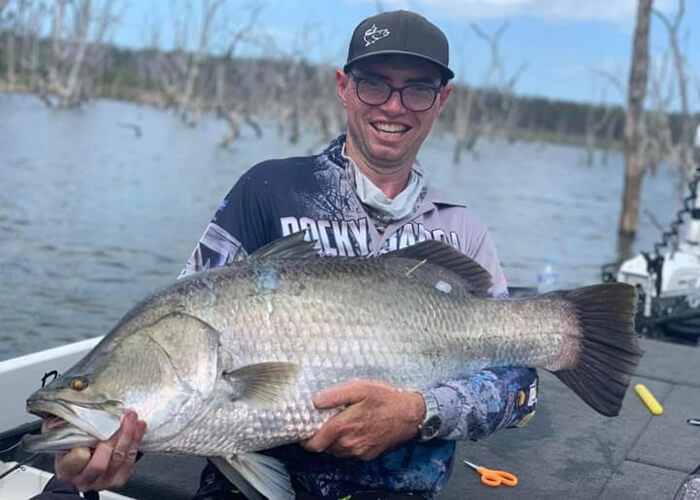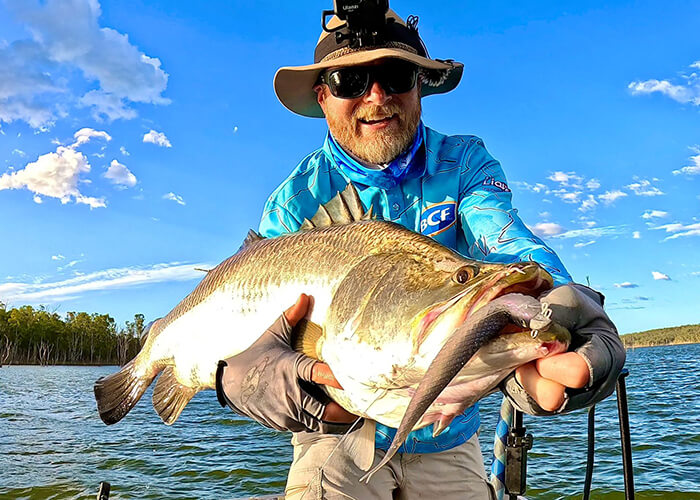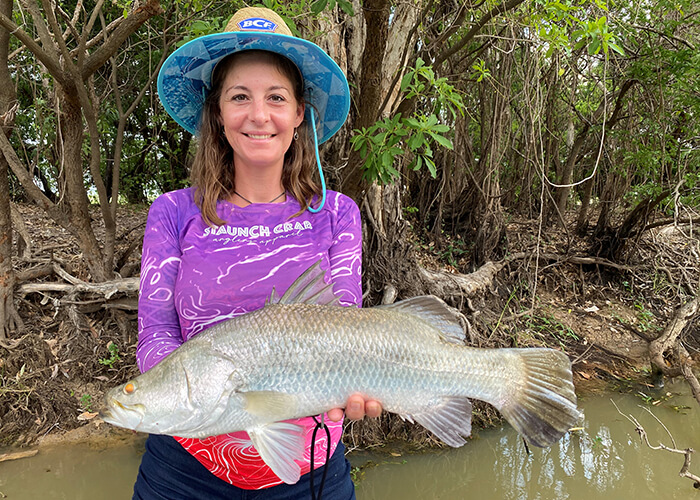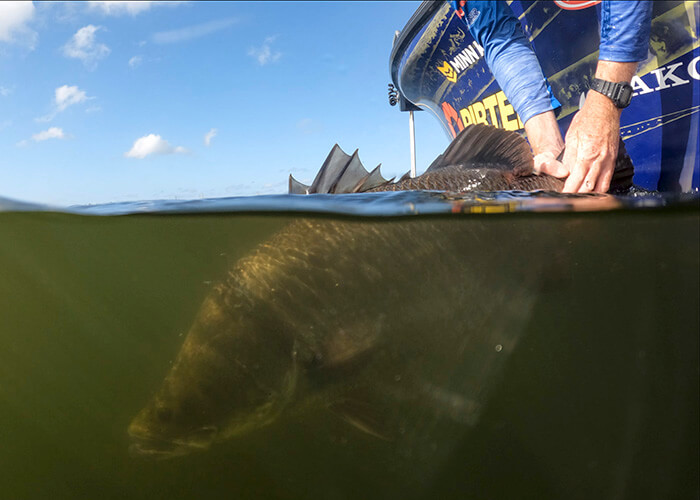Although us Aussies are lucky enough to have some pretty epic fish species that call our waters home, safe to say there's one that touches the hearts of anglers like no other… the barramundi! Considered hands down Australia's most iconic fish species, barra are not only our homegrown hero, but also revered by many fishos around the globe who want to travel down under and give barra fishing a crack.
There's plenty of reasons why barramundi are so popular; their incredible brute strength (with more muscles than an oyster farm), their hefty growing potential (easily surpassing the magic metre), their table quality that's arguably one of the best, and their acrobatic antics when hooked (that has to be seen to be believed)!
Now, they certainly aren't the easiest fish to catch, but once you've caught your first one – you'll be hooked! To help point you in the right direction, our BCFing experts have thrown together this epic guide full of top tips for catching big bad Bazza!

Where to catch Barramundi
Barramundi can be found in various locations throughout the northern half of Australia, from as far down as Brisbane on the east coast, all throughout the top end and down to Shark Bay in WA. These guys can't get enough of the warmer water temps found in these areas, and who could blame them! Barra are unique in that they thrive in both fresh and saltwater environments, with many spending a portion of their lives way upstream before venturing down to the salt as they get bigger. Barra love their tidal movement and use it for an easy feed. The age-old “no run no fun” is pretty spot on with these guys.
What gear to use for Barramundi
When fishing for barramundi, it's important to use gear that can handle their strength and aggressive nature. While they aren't the dirtiest fighters, they certainly shouldn't be underestimated, as barra have plenty of tricks up their sleeve. When looking at gear, baitcaster rods and reels are easily the most popular choice due to the accuracy and control they provide. Barra are another species who love their structure, which is why a shorter rod is the way to go. Choose any stick between 6'-6'6” in length and 4-8 or 8-10kg in weight to ensure you've got enough pulling power. Match that with a 200-250 size baitcaster reel, and you should be in business. Baitcasters aren't for everyone, and that's completely fine! If fishing with a spinning setup suits you better, go long! Any spinning rod between 6'6” – 7' in length and that same 4-8 or 8-12kg is perfect. Match that bad boy up with a 4000-5000 size spinning reel, and voila!
Best bait for Barramundi
Sinking baits can be an extremely effective way to target barra, and at times, the only thing that'll get them to bite. Going with a bait that closely resembles their natural diet is how you'll get best results with both live and dead baits having their place. Barramundi are very much opportunistic feeders and tend to eat just about anything that'll fit in their rather large gobs. Prawns, mullet, herring and garfish are all ripper live bait options, and at times, can be harder to catch than Barry himself. If you don't have time to collect your own bait, head to your local BCF for a huge selection of dead baits including mullet, prawns, whitebait, and pilchards.
Although bait choice is important, presentation is even more so! As you'd expect, you want your presentation to look as natural as possible, with either lightly weighted or completely unweighted being preferred – however heavy you need to go to deal with tidal flow! When it comes to hooks, it's not bigger is better, you want something you can easily disguise in your bait offering. Hooks around the 2/0 – 5/0 size range are perfect, with single circles making for a better hook set and a safer option for the fish. By keeping a collection of different hooks, sinkers, and swivels close at hand, it allows you to tweak your setup to help you get the bite.

Best lures for Barramundi
That unmistakable double-tap as a hungry barramundi wraps its jaws around your lure and starts heading for the horizon, now this is living! Any fisho who's caught a barra on lure will agree there's no better way! Not only is it super effective for targeting barra, but it'll have you grinning from ear to ear when one jumps on. When it comes to what lure you go with, there really is no hard or fast rule. As with their bait preferences, barra aren't the fussiest of fish. Soft plastic minnows in the 4-6in range are always a winner and something you shouldn't leave home without. Hard bodied jerkbaits would have to be one of the most popular barra lures with both shallow and deep divers having their day – depending on the depth! 90-120mm vibes are good at enticing a reactive strike and should have a place in any barra box. Trying a few different options until you find what works is key. As for colour, truth is, they all work! Depending on the colour of the water, you'll find something natural is always a winner in clear water, with bright colours taking centre stage in the dirty stuff. If in doubt black and gold!
Barra may seem like gentle giants, but they do have a temper. Like any other fish, they aren't hungry all the time, but can be provoked into making a reactive strike if you push the right buttons. If you want a thrill like no other, get your hands on a surface lure. These guys are implosion feeders and the boof they make when taking something from the top will leave you weak at the knees.

When to catch Barramundi
Barramundi are a species that are most active during the warmer months, particularly in the wet season from December to March. This coincides with the run-off, a time of the year that sees fishos of all ages heading for FNQ and the NT ready to get stuck into some insane fishing.
Barra are much more aggressive during the early morning and late afternoon. You know what they say… the early bird gets the barra! When it comes to tides, these beauties can be caught at all stages, with a rising tide or just before the high being optimal. Once spring and summer have been and gone, that doesn't mean barramundi are completely off the menu. If you're really looking for a barra fix, you can head to the top end where these guys will be on tap all year long or give one of the many freshwater impoundments a crack. Although their metabolism slows to deal with the cold, they still have to eat!
In Australia, the closed season for barramundi varies depending on the state or territory. However, most regions have a closed season to protect barramundi during their spawning period. For more details, head to your state fisheries website!
- East Coast: The closed season runs from 1 November to 31 January each year, and during this time, the species is prohibited from being deliberately targeted
- Gulf of Carpentaria: Slightly different from the east coast. Here, the closed season extends from 7 October to 31 January
- Northern Territory: Fortunately for fishos in the top end, there is no closed season for barramundi and they can be targeted all year round
- Western Australia: In the Kimberley region of WA, the closed season runs from 1 November to 31 January
Information accurate as of 24/03/2025. Be sure to check with your local marine authorities if you're unsure of any changes to the barramundi closed season in your area
Final pointers
- Bring with you a variety of different lures that you can chop and change between until you find what works.
- Retrieval techniques all have their place. Some days they will want it fast, some days they'll want a slow roll, and others the long pause will be the way to go.
- While an airborne barra is a sight to behold, it's also when they are best at throwing lures. Keep your rod tip down and a steady pressure.
- They aren't always easy! Be patient and stay persistent.
- Barra have some serious spines. When handling, you need to be careful – hand in the mouth and HOLD ON TIGHT!

Barramundi fishing is as much about the journey as it is the catch! Whether you're new to the game or it's part of your bread and butter once you've caught the barra bug you'll be hooked for life (pardon the pun). Hopefully this how-to guide has come in handy, now get out there and put the brakes on a barra!


